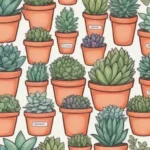
Creating a Perfect Succulent Garden with the Right Tools

Introduction
Succulents have gained immense popularity in recent years, not only for their captivating appearance but also for their low-maintenance nature. Their ability to thrive in various environments while requiring minimal water makes them an ideal choice for both novice and experienced gardeners. These fascinating plants come in an array of colors, shapes, and sizes, allowing the creation of stunning displays in virtually any setting.
In this article, we aim to walk you through the steps necessary for creating a perfect succulent garden, emphasizing the importance of choosing the right tools. As we explore the essentials for crafting a thriving succulent garden, we will delve into the specific tools that can simplify the planting process and maximize your gardening success. From the basic tools to specialized equipment, you'll find everything you need to get started on your succulent journey.
Understanding Succulent Gardens
Creating a succulent garden is not merely about planting these hardy plants in a container or a patch of soil; it's about designing an aesthetically pleasing environment that complements their unique attributes. A succulent garden can be a centerpiece in your home, a soothing addition to your outdoor landscape, or even a way to enhance your indoor air quality.
Succulents come from a variety of habitats, ranging from arid deserts to high mountain regions. These plants store water in their leaves, stems, and roots, which enables them to survive in harsh conditions. Thus, when planning your succulent garden, you need to consider factors such as location, light exposure, and watering needs. Understanding these requirements will help you select the appropriate plants and create a balanced ecosystem.
Consider using a variety of succulents to achieve diverse textures and colors. Mixing species such as Echeveria, Sedum, and Aloe can create a visually dynamic garden that captures interest throughout the seasons. Incorporating elements like rocks, driftwood, or ornamental stones can further enhance the overall visual appeal, offering a more natural appearance to your succulent garden.
Selecting the Right Location for Your Succulent Garden
Finding the ideal location for your succulent garden is crucial for successful growth and durability. Most succulents thrive in bright, indirect light, although certain species can handle direct sunlight. It's important to consider the microclimate of your garden space, evaluating exposure to the sun throughout the day and any potential shade areas that may inhibit growth.
When selecting an outdoor location, observe how much sunlight various areas receive. Ideally, your succulents should receive at least six hours of sunlight daily. If you are setting up an indoor succulent garden, choose a south or west-facing window to maximize natural light exposure. However, be cautious of too much sun exposure indoors, as it can lead to sunburn on your delicate plants.
 Seasonal Gardening Tools for Year-Round Succulent Care
Seasonal Gardening Tools for Year-Round Succulent CareThe quality of the soil in your chosen location also plays a crucial role in the health of your succulents. Well-draining soil is essential, as succulents are particularly sensitive to overwatering. If the soil retains too much moisture, your plants may suffer from root rot. Testing the soil's drainage capabilities helps ensure it is suitable for your garden. If your soil doesn't drain well, consider raising your garden bed or utilizing containers with drainage holes.
Essential Tools for Creating Your Succulent Garden

Having the right tools at your disposal is vital for any gardening project, especially when creating a succulent garden. These essential tools can simplify the process, improve efficiency, and help ensure the health of your plants.
1. Basic Gardening Tools
Basic gardening tools include the foundational equipment needed for any planting project. A trowel is essential for digging holes and transferring soil, while a hand rake will help you prepare soil by breaking up clumps and removing debris. Additionally, a pair of gloves will protect your hands from soil, thorns, and irritants.
You may also want to have a pruning snip on hand to trim and shape your plants as they grow. Succulents can have a tendency to become leggy or overgrown, and regular trimming will help maintain their shape and health. For larger succulent arrangements, a shovel or spade is beneficial for moving larger amounts of soil.
2. Specialized Succulent Tools
Beyond the basic tools, certain specialized equipment can significantly enhance your gardening experience. For example, a soil moisture meter can help you gauge the moisture level in your succulent soil, giving you a clearer idea of when to water. Since succulents are particularly sensitive to overwatering, this tool can be invaluable in maintaining proper care.
Another useful tool is a watering can specifically designed for succulents. Opt for one with a long spout to allow for precise watering, ensuring that water reaches the base of the plant without saturating its leaves. A squeezy bottle can also be beneficial for precisely hydrating individual plants without worrying about accidental overwatering.
 Top 10 Hand Tools for Ultimate Succulent Care and Maintenance
Top 10 Hand Tools for Ultimate Succulent Care and MaintenanceFor those interested in creating visually appealing fairy gardens or terrariums, consider adding a scooping tool or tweezers to your toolkit. These tools can help position small decorative elements and manage delicate plants without disturbing the surroundings too much.
3. Containers and Potting Supplies
When it comes to containers, the options are virtually limitless, and choosing the right ones can make a substantial impact on the aesthetic of your succulent garden. Succulents thrive in pots with drainage holes, allowing excess moisture to escape easily. Terracotta pots are a popular choice due to their porous nature, promoting airflow and moisture regulation.
Prepare your pots with high-quality cactus and succulent soil, which is typically faster draining than regular potting soil. For added drainage, you can incorporate materials like perlite or sand into the mix. Make sure to add a layer of small stones at the bottom of your pots to prevent soil from clogging the drainage holes.
Don’t overlook the importance of selecting decorative elements that complement your garden’s theme. From charming mini pots to colorful dish gardens, these design choices can elevate your succulent aesthetic and create a visually striking focal point in your home or garden.
Caring for Your Succulent Garden
Now that your succulent garden is in place, ongoing care is essential for thriving plants. It is vital to establish a routine that includes proper watering, light management, and pest control to ensure long-term success.
1. Watering Techniques
Watering succulents effectively requires a balance—too much water can lead to root rot, while too little may cause your plants to shrivel. One effective method to gauge when to water is the "soak and dry" method: water your succulents thoroughly until the water drains through the bottom, and then allow the soil to dry out completely before the next watering.
In general, succulents need to be watered less frequently in the Spring and Fall while growing and more during the dry summer months when they are actively photosynthesizing. Factors such as temperature and humidity also play a role in watering schedules. As you become more familiar with your garden, you’ll develop a better understanding of your plants’ specific needs.
 How to Choose the Right Tool for Succulent Replanting Tasks
How to Choose the Right Tool for Succulent Replanting Tasks2. Light Management
Positioning your plants correctly in relation to light sources is crucial for healthy growth. While too much sunlight can scorch delicate leaves, insufficient light can lead to leggy or stressed plants. Monitor your succulents closely to observe their growth behavior. If they reach towards light or develop discoloration, it may be time to adjust their location.
In colder climates, consider moving potted succulents indoors during harsh winters to shield them from extreme temperature fluctuations. Using grow lights can also be an effective solution for providing adequate light in environments with limited natural sunlight.
3. Pest Control
Though succulents are often less prone to pests than other plants, they can still fall victim to various issues. Keep an eye out for aphids, mealybugs, and spider mites, which may infest your plants. If you notice pests, consider treating your garden with insecticidal soap or horticultural oil, applied following the product’s instructions.
Regularly inspecting your succulents and maintaining a clean garden space will help minimize pest infestations. Additionally, good air circulation around your succulent plants can prevent mold and mildew growth, further safeguarding the health of your garden.
Conclusion
Creating a succulent garden can be an incredibly rewarding and enriching experience that allows you to explore your creativity while nurturing these resilient plants. By understanding the unique requirements of succulents and selecting the right tools, you set yourself up for success in cultivating a visually stunning garden that brings joy for years to come.
Take the time to plan your garden meticulously, from choosing the right location to selecting appropriate containers and soil, to ensure a thriving environment. Leverage the intended tools to simplify the planting process and maintain your garden's health over time. As your succulent collection flourishes, allow yourself to get creative with design, incorporating various textures, colors, and even decorative elements to personalize your space.
Above all, remember to enjoy the process of growing your succulent garden. Over time, you will find immense satisfaction in watching your plants thrive and evolve. Through dedication, attention to detail, and a touch of creativity, you can create a miniature oasis that celebrates the beauty and resilience of succulent plants, contributing to your home decor while enhancing your well-being. Happy gardening!
 Best Labeling Tools for Organizing Your Succulent Collection
Best Labeling Tools for Organizing Your Succulent CollectionIf you want to read more articles similar to Creating a Perfect Succulent Garden with the Right Tools, you can visit the Gardening Tools category.

You Must Read